Study on Bond Anchorage Behavior of Small-Diameter Rebar Planting under Medium and Low Cycle Fatigue Loads
Abstract
:1. Introduction
2. Pull-Out Test
2.1. Purpose and Process
2.2. Specimen Design
2.3. Fatigue Loading
2.4. Loading System of Pull-Out Test
3. Analysis of the Pull-Out Test Results
3.1. Failure Modes and Ultimate Loads
3.2. Load–Slip Curve
3.3. Elastic Ultimate Load
3.4. Axial Strain of Steel Bar
4. Numerical Simulation of the Adhesive–Rebar Interface
4.1. Establishment of FE Model
4.2. Bond–Slip Constitutive Relationship of the Adhesive–Rebar Interface under Medium and Low Cycle Fatigue Loads
- (1)
- Average ultimate bond stress
- (2)
- Elastic stage ultimate bond stress
- (3)
- Ultimate load slip displacement
- (4)
- Elastic stage ultimate slip displacement
- (5)
- Residual slip displacement
- (6)
- Residual bond strength
- (1)
- Elastic bond stage
- (2)
- Elastic–plastic slip stage
- (3)
- Destructive decline stage
4.3. Spring Stiffness
5. Numerical Model Validation
5.1. Comparison of Load–Slip Curves
5.2. Rebar Stress
6. Elastic Ultimate Load under Medium and Low Cycle Fatigue Loads
6.1. Analysis of Influencing Factors
6.2. Formula Fitting
7. Discussion
- According to the ISO standard [40], the minimum allowable diameter of steel bar is 6 mm. Although there is no specific grade classification for the diameter of steel bars in the standard, in the engineering practice in China, steel bars with diameters of 6 mm, 8 mm and 10 mm are generally defined as small-diameter steel bars. In this study, a total of 24 single rebar planting specimens with diameters of 6 mm and 8 mm were tested, and the differences and change rules of the bond anchorage performances of rebar planting specimens under medium and low cycle fatigue loads were obtained. Although there may be some deficiencies in the number of test samples, this paper still studied the category of small-diameter rebar planting completely and obtained several similar analysis results and the formulas of the elastic ultimate load for 6 mm and 8 mm diameter rebar plantings. The next research direction could be to expand the number of test samples and expand the study to more diameters to obtain more comprehensive research conclusions. In order to obtain a more comprehensive and accurate quantitative formula for the performance of rebar plantings, a comparative test could be carried out between rebar planting with a diameter of 10 mm and a larger diameter.
- In this study, a formula to quantify the elastic ultimate load of small-diameter rebar planting under the influence of fatigue load and anchor depth is proposed, which provides a reference for the design of rebar planting. And this paper could also provide an idea for the performance detection of rebar planting in a fatigue environment. From the test results of this study, it can be seen that even when the rebar plantings were in ductile failure (rebar fracture) and there was no significant difference in the ultimate load, the slip amount of the rebar planting specimen subjected to fatigue loading was significantly greater than that of the control specimen without fatigue loading under the same conditions, especially when the anchor depth was small. However, the excessive slip of the planted rebar is obviously not conducive to the connection and anchorage of the structure. Therefore, the evaluation of the performance of rebar planting can not only be limited to its ultimate load [36], but we also can further introduce the quantitative requirement of slip values, so that the performance deterioration degree of rebar planting affected by fatigue load can be further evaluated on the basis of the rebar fracture, so as to avoid potential security threats.
- Through experiments and finite element simulation, this study obtained that the suitable anchorage depth of single rebar planting under a low and medium cycle fatigue load was 20d, which provided a certain reference for the design of rebar planting under similar fatigue environments. But in engineering applications, as a means of post-installation, rebar planting often undertakes the function of strengthening structures and components. Therefore, it might be a more practical research direction to study the fatigue performance and reliability of rebar planting components, which is also one of the limitations of our current research. In the future, similar fatigue tests will be carried out to study the fatigue mechanical properties [41] and the fatigue reliability assessment [42] of rebar planting specimens to verify the research conclusion of this study, which is the foreseeable research direction going forward.
8. Conclusions
- The ultimate drawing load of 6 mm and 8 mm small-diameter planting rebars under the medium and low cycle fatigue loads of 10,000~100,000 times does not change significantly, but the ultimate load slip displacement, elastic ultimate load and elastic stage ultimate slip displacement are significantly affected. When the anchor depth is the same, as the number of fatigue loading increases, the ultimate load slip displacement shows an increasing trend, and the elastic ultimate load decreases as the number of the loading increases. By increasing the anchor depth, the influence of fatigue load on the anchoring performance of the rebar planting specimen can be reduced. The increase in anchor depth cannot infinitely improve the elastic ultimate load of rebar planting under the medium and low cycle fatigue loads. When the anchor depth increased to 20d, the elastic ultimate load of the rebar planting was close to the load level without fatigue loading, and it was no longer effective to continue to improve the anchor depth. Under the premise of considering the economic cost, it is recommended that the design depth of rebar planting for similar projects should be 20d.
- When the diameter of the steel bar and the anchor depth are the same, the strain level of the overall steel bar of the fatigue-loaded specimen is lower than that of the specimen without fatigue loading. With the increase in the relative depth, the influence gradually decreases until the bottom influence basically disappears. With the increase in the drawing load, the strain value of the free end of the steel bar increases the fastest, and the growth rate of the strain value gradually decreases along the depth direction. Fatigue load has no obvious effect on the axial strain distribution of rebar planting, and the strain value is always distributed from large to small according to the law of orifice–middle–bottom.
- Through the fitting results of the elastic ultimate load of a large number of finite element numerical models, considering the joint influence of the two factors of anchor depth and fatigue loading times on the elastic ultimate load of rebar planting, it is concluded that the elastic ultimate load of rebar planting with the two diameters of 6 mm and 8 mm is a two-dimensional quadratic function with respect to anchor depth and fatigue loading times as independent variables.
Author Contributions
Funding
Institutional Review Board Statement
Informed Consent Statement
Data Availability Statement
Conflicts of Interest
References
- Yuko, S.; Satoshi, Y.; Shoichi, K.; Takashi, H.; Toru, T. Method of reinforcement for joints between steel roofs and RC columns in existing buildings. Eng. Struct. 2020, 209, 110255. [Google Scholar]
- Matteo, B.; Alessandra, A.; Joaquim, A.O.B. Shear strengthening of reinforced concrete beams strengthened using embedded through section steel bars. Eng. Struct. 2014, 81, 76–87. [Google Scholar]
- Wang, D.; Wu, D.; He, S.; Zhou, J.; Ouyang, C. Behavior of post-installed large-diameter anchors in concrete foundations. Constr. Build. Mater. 2015, 95, 124–132. [Google Scholar] [CrossRef]
- Brencich, A. A post-installed insert for pull-out tests on concrete up to 70 MPa. Constr. Build. Mater. 2015, 95, 788–801. [Google Scholar] [CrossRef]
- Ronald, A.C. Behavior of chemically bonded anchors. J. Struct. Eng. 1993, 119, 2744–2762. [Google Scholar]
- Ronald, A.C.; Jacob, K.; Werner, F.; Robert, C.K. Behavior and design of single adhesive anchors under tensile load in uncracked concrete. Aci. Struct. J. 1998, 95, 9–26. [Google Scholar]
- Ronald, A.C.; Robert, C.K. Factors influencing bond strength of adhesive anchors. Aci. Struct. J. 2001, 98, 1154–1168. [Google Scholar]
- Michael, M.; Ronald, A.C.; Kailash, K. Pullout simulation of postinstalled chemically bonded anchors. J. Struct. Eng. 1996, 122, 1016–1024. [Google Scholar]
- Kilic, A.; Yasar, E.; Atis, C.D. Effect of bar shape on the pull-out capacity of fully-grouted rockbolts. Tunn. Undergr. Sp. Tech. 2003, 18, 1–6. [Google Scholar] [CrossRef]
- Zhou, X.; Wang, Y.; Qu, S. Ultimate load carrying capacity analysis of adhesively bonded bars in concrete. Eng. Mech. 2002, 6, 82–86. [Google Scholar]
- Wang, D.; Wu, D.; Ouyang, C.; He, S.; Sun, X. Simulation analysis of large-diameter post-installed anchors in concrete. Constr. Build. Mater. 2017, 143, 558–565. [Google Scholar] [CrossRef]
- Wang, D.; Wu, D.; Ouyang, C.; Zhai, M. Performance and design of post-installed large diameter anchors in concrete. Constr. Build. Mater. 2016, 114, 142–150. [Google Scholar] [CrossRef]
- Bassam, A.T.; Zeyad, M.E.; Samir, S.; Moruf, O.Y. Pull-out behavior of post installed rebar connections using chemical adhesives and cement based binders. J. King Saud Univ. -Eng. Sci. 2019, 31, 332–339. [Google Scholar]
- Wang, C.P.; Wu, S.M.; Wang, C.K.; Pan, H.Y. Tensile capacity of post-Installed rebars in concrete structure. Adv. Mater. Res. 2011, 1279, 255–260. [Google Scholar] [CrossRef]
- Salih, Y.; Muhammet, A.Ö.; Yavuz, Y. Tensile behavior of post-installed chemical anchors embedded to low strength concrete. Constr. Build. Mater. 2013, 47, 861–866. [Google Scholar]
- Zavliaris, K.D.; Kollias, S.; Speare, P.R.S. An experimental study of adhesively bonded anchorages in concrete. Mag. Concrete Res. 1996, 48, 79–93. [Google Scholar] [CrossRef]
- Ling, Z.; Yang, H.; Liu, W.; Lu, W. Experimental study on bond and anchorage behavior of glued-in rebar in glulam. J. Build. Struct. 2013, 34, 132–141. [Google Scholar]
- Otero, C.M.D.; Estévez, C.J.; Martín, G.E.; Vázquez, R.J.A. Influence of timber density on the axial strength of joints made with glued-in steel rods: An experimental approach. Int. J. Adhes. Adhes. 2010, 30, 380–385. [Google Scholar] [CrossRef]
- Zhou, B.; Lv, X.; Ren, X. Theoretical analysis and experimental research of pull-out behavior of bonded steel bar embedded in brick wall of existing masonry structure. J. Build. Struct. 2012, 33, 132–141. [Google Scholar]
- Zhang, G.; Shi, K.; Li, Y. Experimental study on seismic behavior of brick walls strengthened with embedded bars. J. Build. Struct. 2013, 34, 145–150. [Google Scholar]
- Liu, X.; Ma, Z. Mechanical behavior analysis of fully grouted bolts under axial cyclic load. Minerals 2022, 12, 1566. [Google Scholar] [CrossRef]
- Liu, Y.L.; Tao, L.X.; Huan, J.H.; Xu, F.Q. Study of the anchorage seismic performance for beam-ends strengthened by bonded rebars. Adv. Mater. Res. 2014, 3137, 783–789. [Google Scholar] [CrossRef]
- Yi, C.; Lee, J.; Hong, K. Effect of low-level cyclic loading on bond behavior of a steel bar in concrete with pre-existing damage. Materials 2021, 14, 7080. [Google Scholar] [CrossRef]
- Lindorf, A.; Lemnitzer, L.; Curbach, M. Experimental investigations on bond behaviour of reinforced concrete under transverse tension and repeated loading. Eng. Struct. 2009, 31, 1469–1476. [Google Scholar] [CrossRef]
- Zhang, Y.; Kim, C.; Zhang, L.; Bai, Y.; Yang, H.; Xu, X.; Zhang, Z. Long term structural health monitoring for old deteriorated bridges: A copula-ARMA approach. Smart. Struct. Syst. 2020, 25, 285–299. [Google Scholar]
- Hawileh, R.A.; Abdalla, J.A.; Tamimi, A.A.; Abdelrahman, K.; Oudah, F. Behavior of corroded steel reinforcing bars under monotonic and cyclic loadings. Mech. Adv. Mater. Struc. 2011, 18, 218–224. [Google Scholar] [CrossRef]
- Zhang, Y.G.; Klingner, R.E.; Gravesiii, H. Seismic response of multiple-anchor connections to concrete. Aci. Struct. J. 2001, 98, 811–822. [Google Scholar]
- Yan, X.; Liang, L.; Liang, C. Bond slip behavior of post-installed anchorage under fatigue load. J. Civ. Environ. Eng. 2020, 42, 149–156. [Google Scholar]
- GB50367-2013; Code for Design of Strengthening Concrete Structure. China Architecture & Building Press: Beijing, China, 2013. (In Chinese)
- GB/T50081-2019; Standard for Test Methods of Concrete Physical Andmechanical Properties. China Architecture & Building Press: Beijing, China, 2019. (In Chinese)
- ISO6892-1:2019; Metallic Materials-Tensile Testing-Part 1: Method of Test at Room Temperature. ISO: Geneva, Switzerland, 2019.
- GB50728-2011; Technical Code for Safety Appraisal of Engineeringstructural Strengthening Materials. China Architecture & Building Press: Beijing, China, 2011. (In Chinese)
- GB/T2567-2008; Test Methods for Properties of Resin Casting Boby. Standards Press of China: Beijing, China, 2008. (In Chinese)
- ISO75-2:2013; Plastics-Determination of Temperature of Deflection under Load-Part 2: Plastics and Ebonite. ISO: Geneva, Switzerland, 2013.
- Ding, K. The effect of frequency on the fatigue strength of steel bars. Ind. Constr. 1989, 11, 26–29. [Google Scholar]
- JGJ145-2013; Technical Specification for Post-Installed Fastenings Inconcrete Structures. China Architecture & Building Press: Beijing, China, 2013. (In Chinese)
- GB50010-2010; Code for Design of Concrete Structures. China Architecture & Building Press: Beijing, China, 2010. (In Chinese)
- Zhang, J.; Huang, H.; Xiao, W.; Wu, J.; Song, L. Experimental research on interface action behavior of adhesive steel bar in concrete. Build. Struct. 2008, 38, 39–42. [Google Scholar]
- Zhang, Z.; Niu, Q.; Liu, X.; Zhang, Y.; Zhao, T.; Liu, M. Durability life prediction of reinforced concrete structure corroded by chloride based on the gamma process. ASCE-ASME J. Risk Uncertain. Eng. Syst. Part A Civ. Eng. Arch. 2021, 7, 04021061. [Google Scholar] [CrossRef]
- ISO6935-2:2015; Steel for the Reinforcement of Concrete-Part 2: Ribbed Bars. ISO: Geneva, Switzerland, 2015.
- Zhang, Z.; Cao, F.; Yang, J.; He, Z. Experiment on natural frequency change of reinforced concrete members under low cycle loading. Shock. Vib. 2018, 2018, 1–17. [Google Scholar] [CrossRef]
- Zhang, Z.; Zhao, C.; Zhao, Z.; Wang, F.; Zhao, B. Structural fatigue reliability evaluation based on probability analysis of the number of zero-crossings of stochastic response process. Eng. Fail. Anal. 2023, 143, 106923. [Google Scholar] [CrossRef]


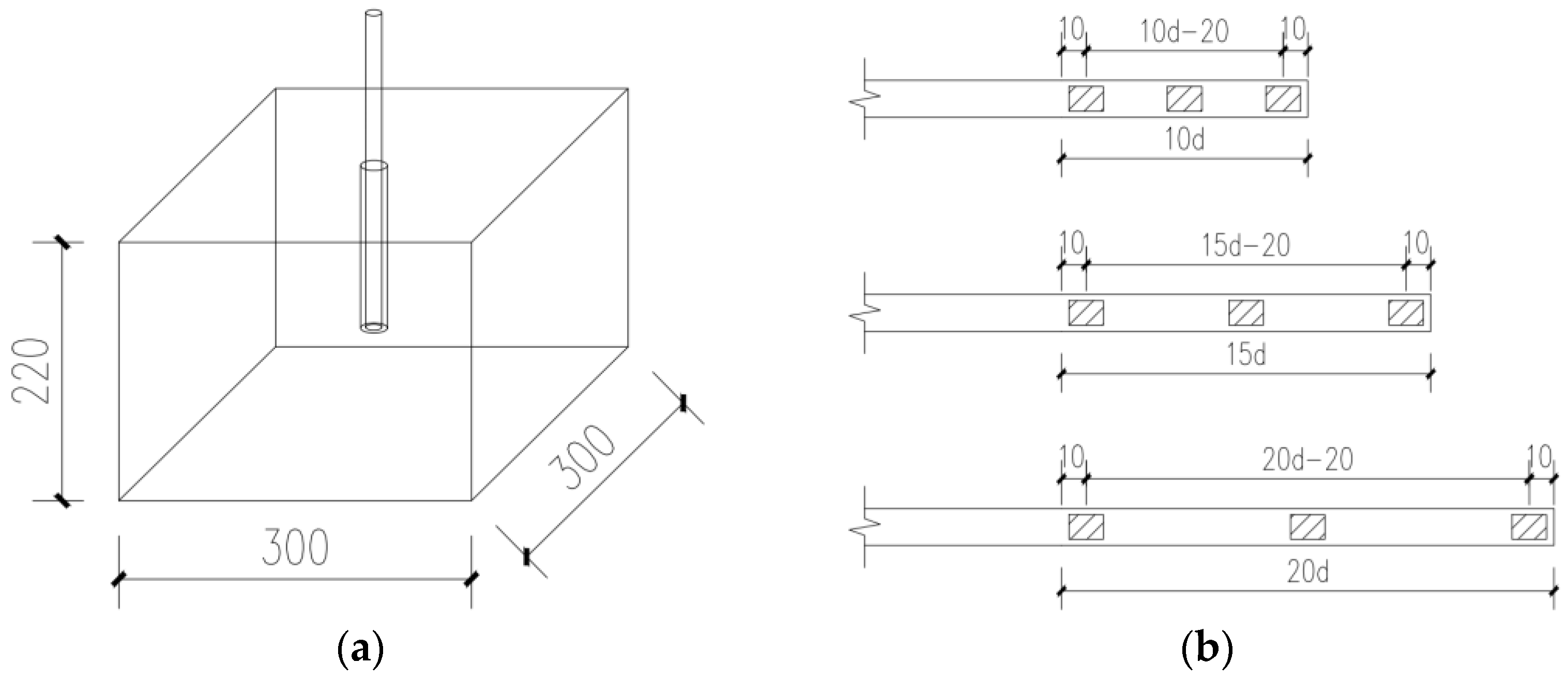

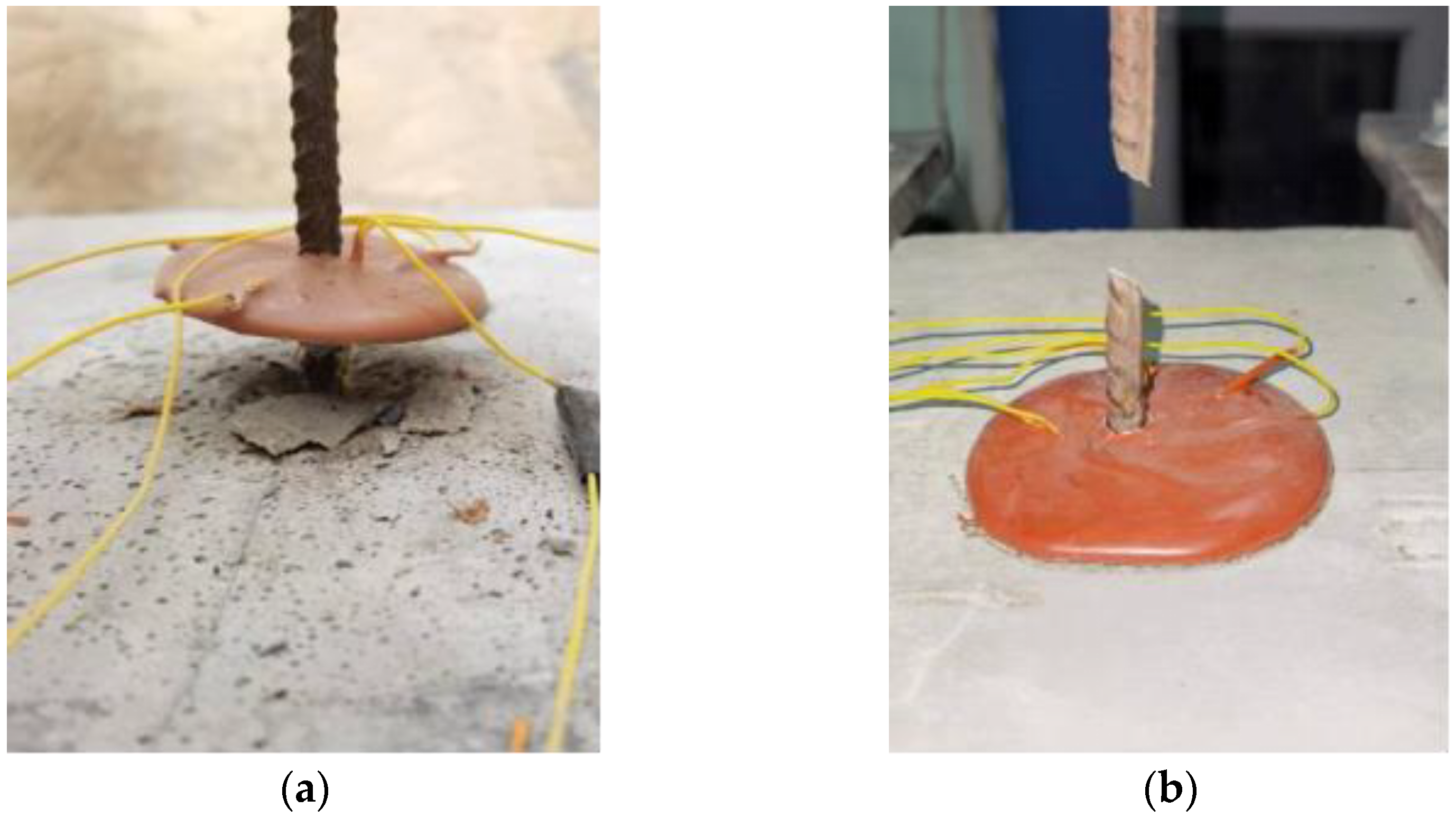
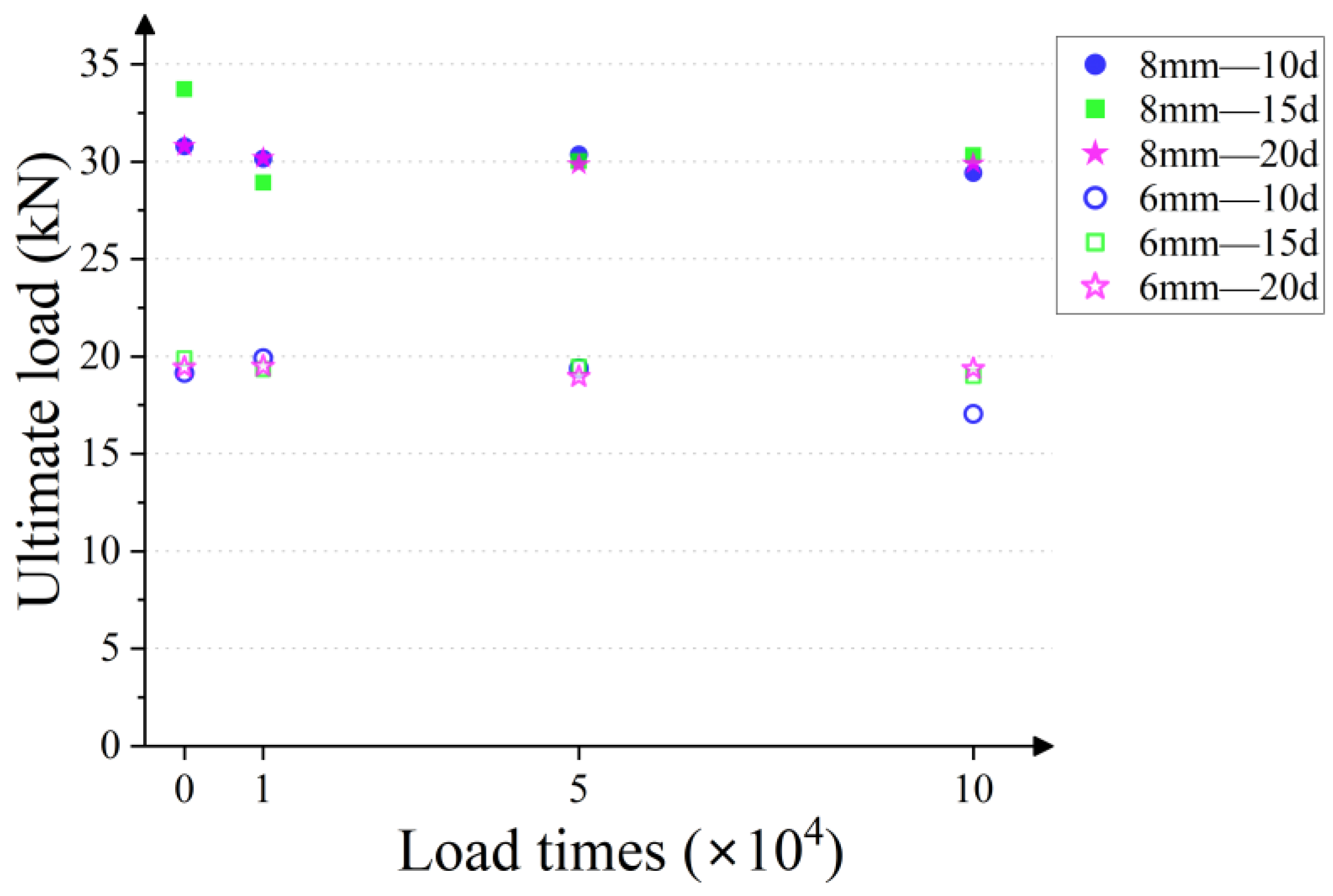
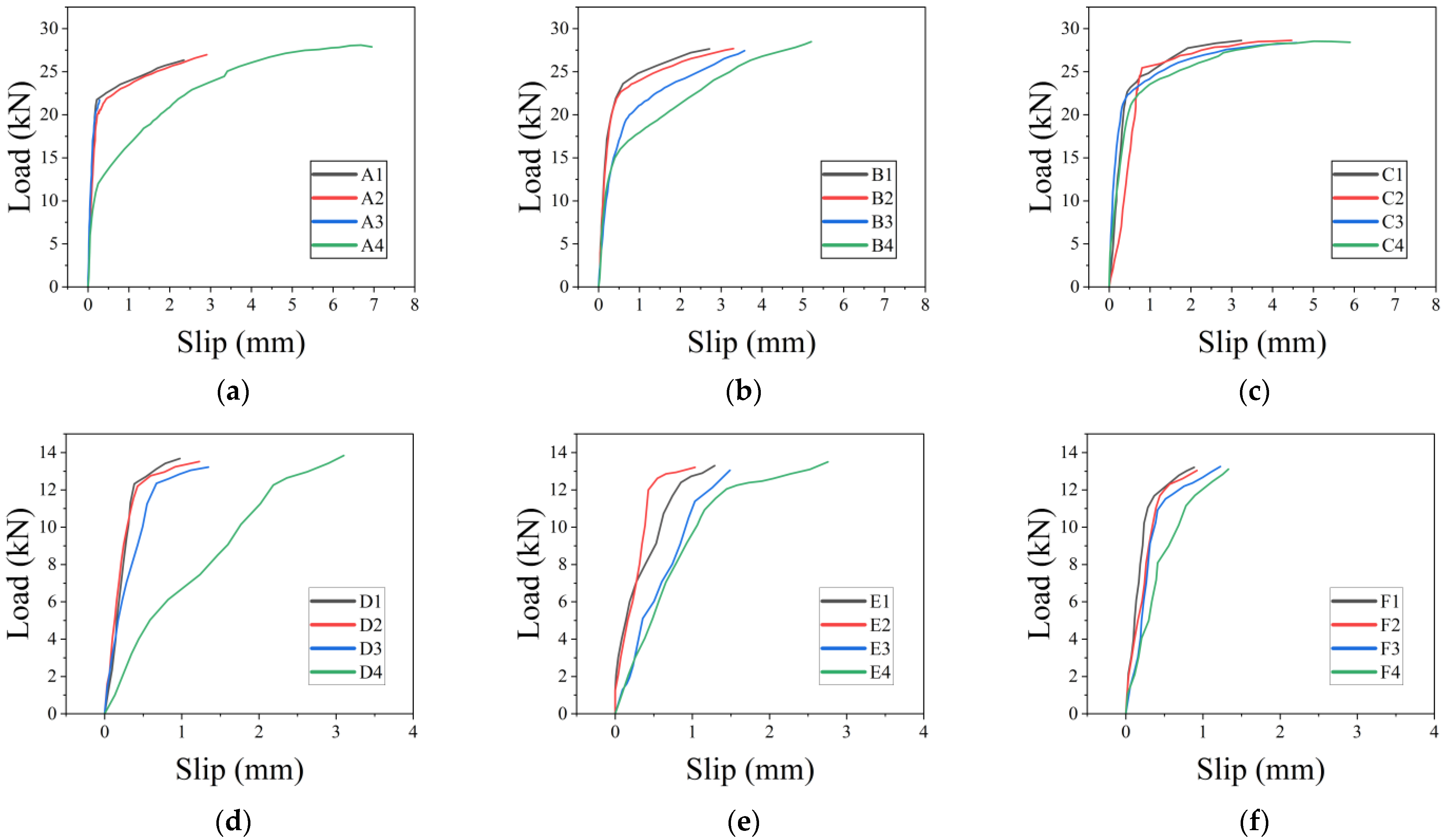
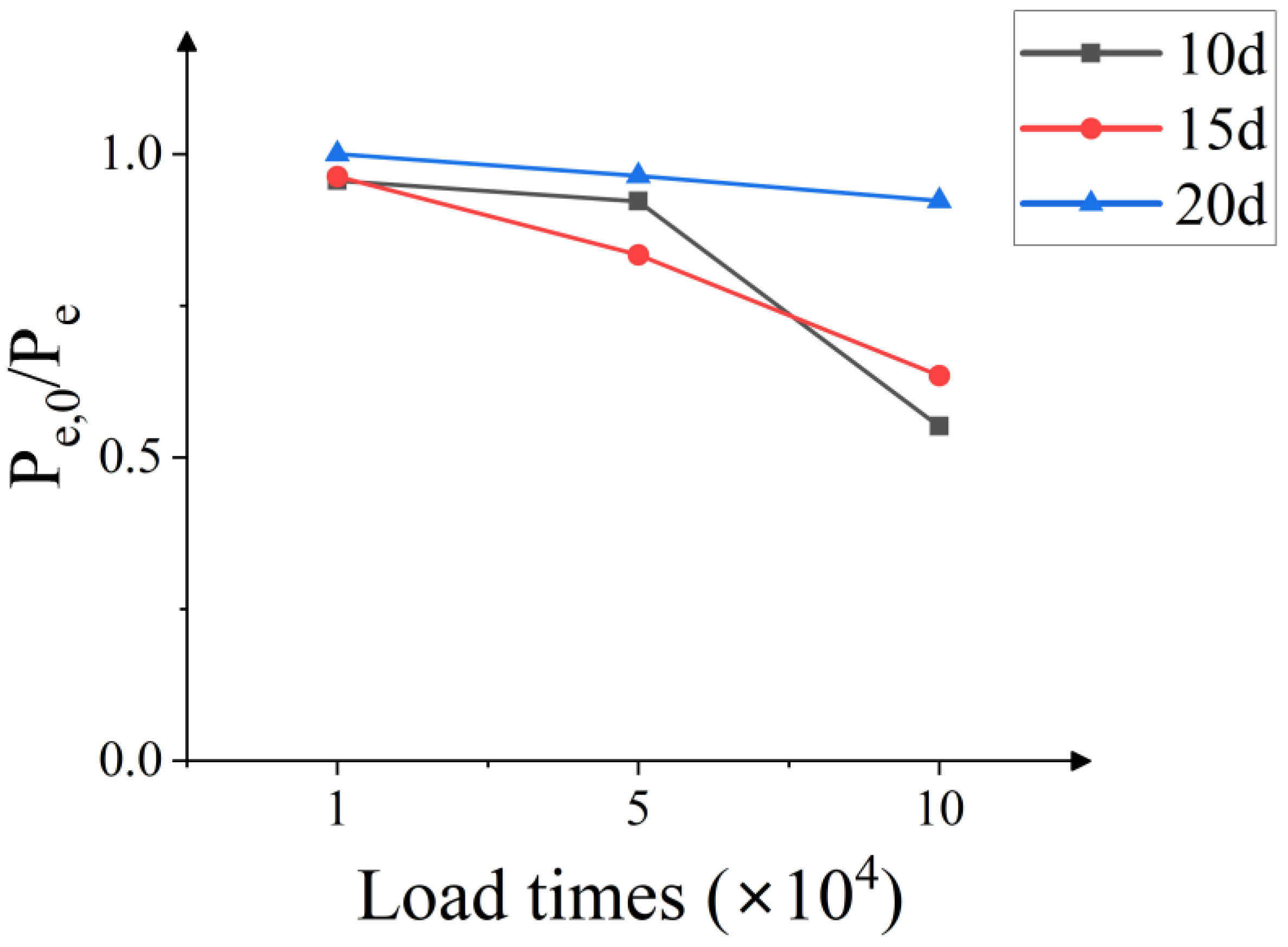

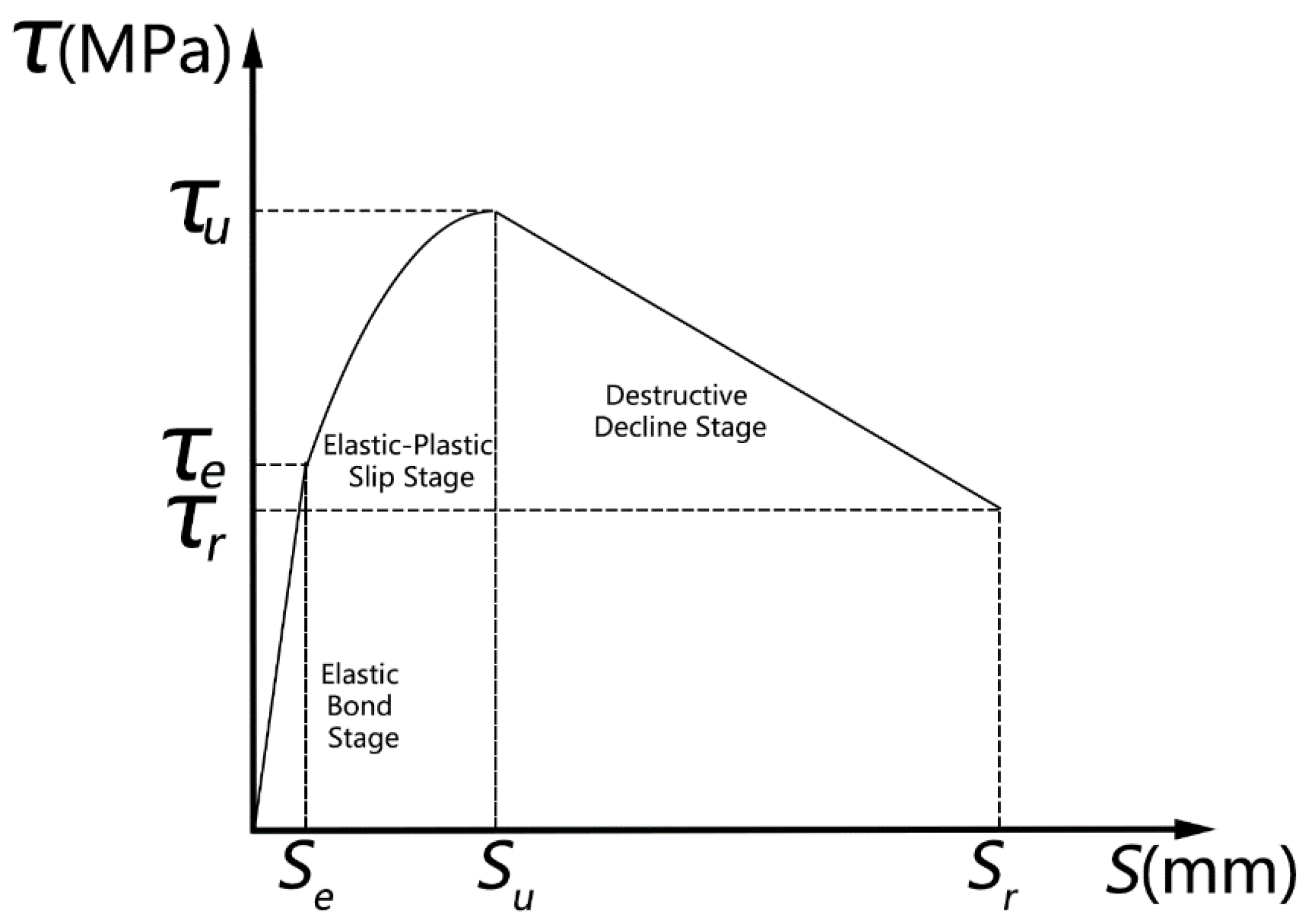
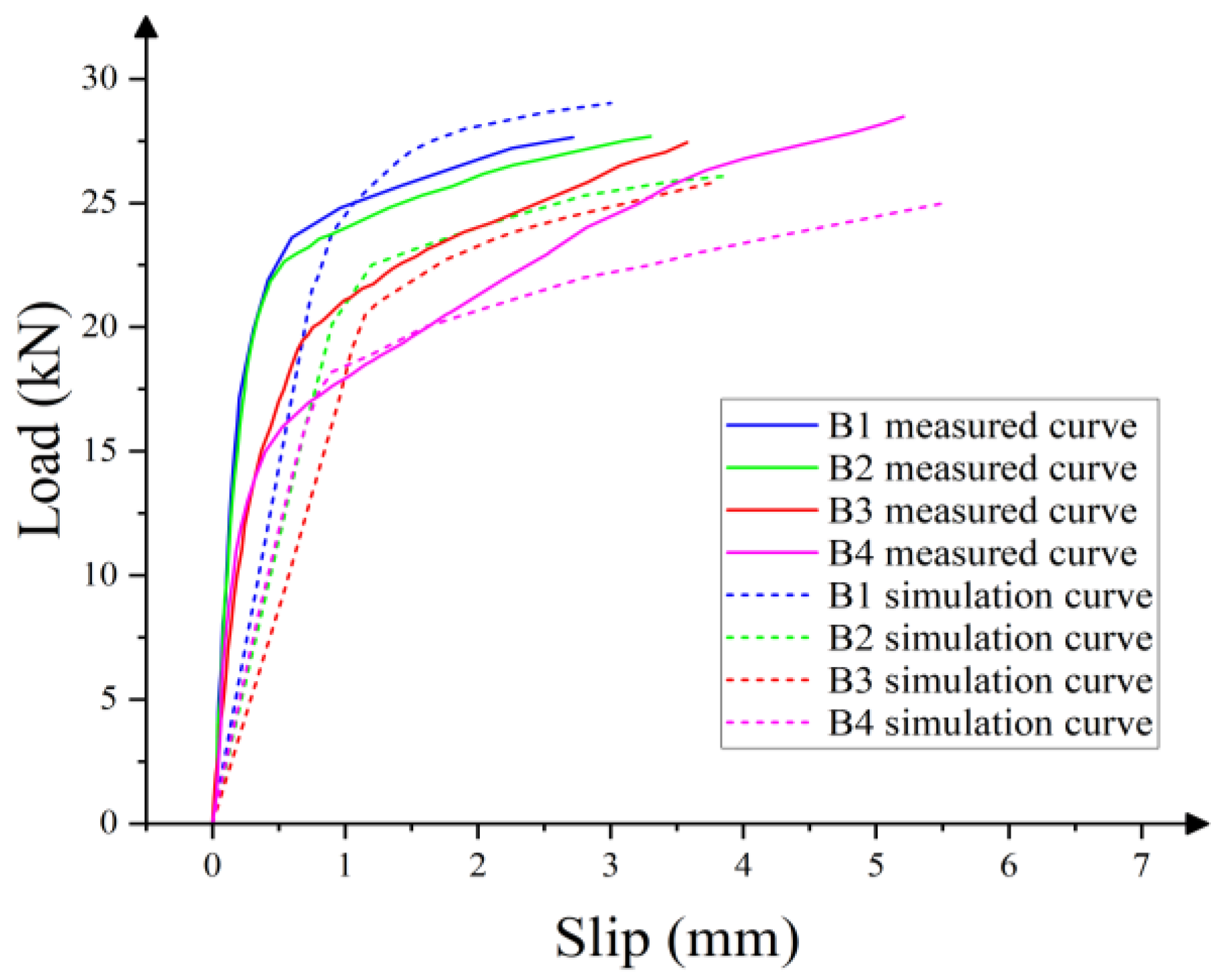
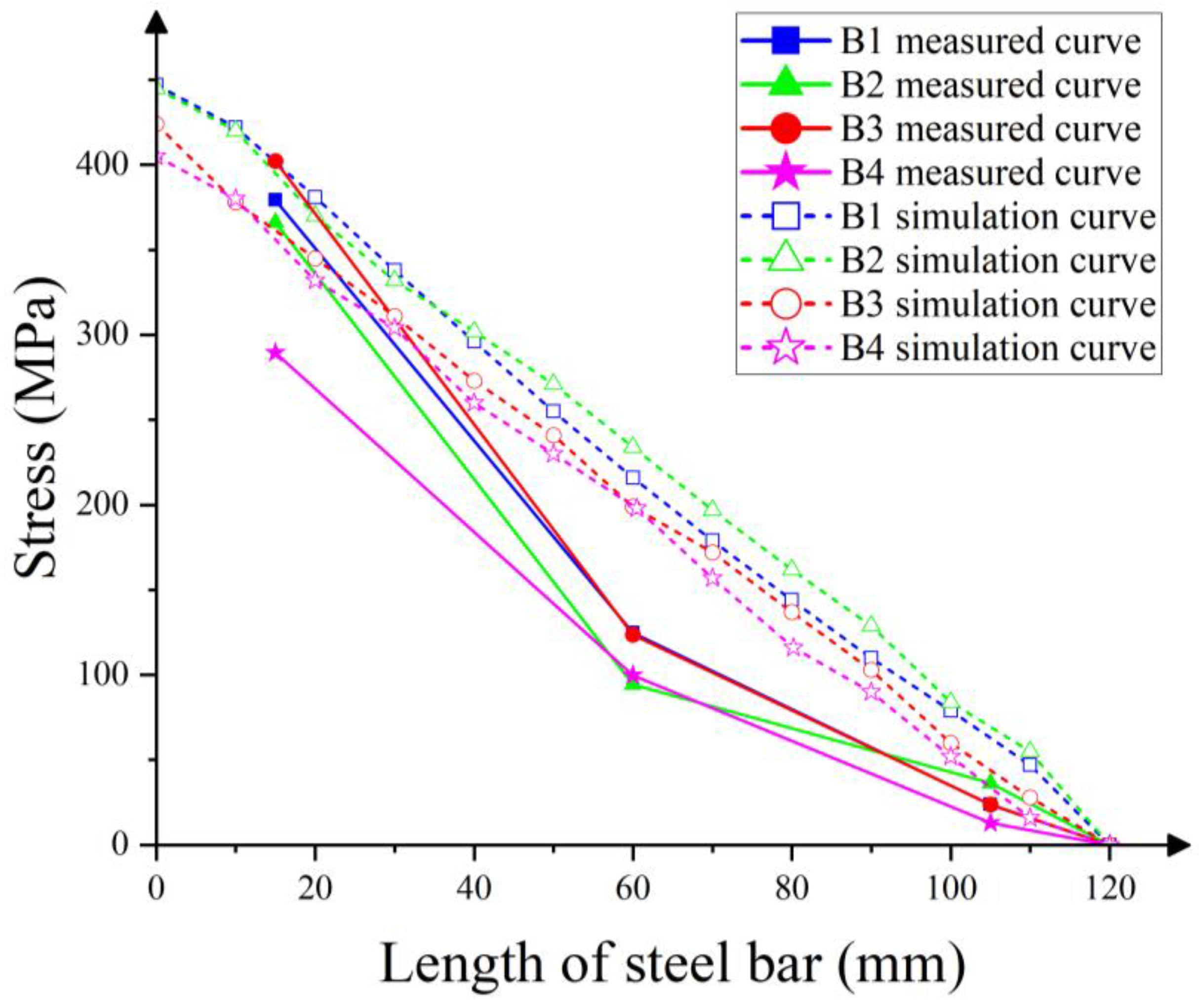
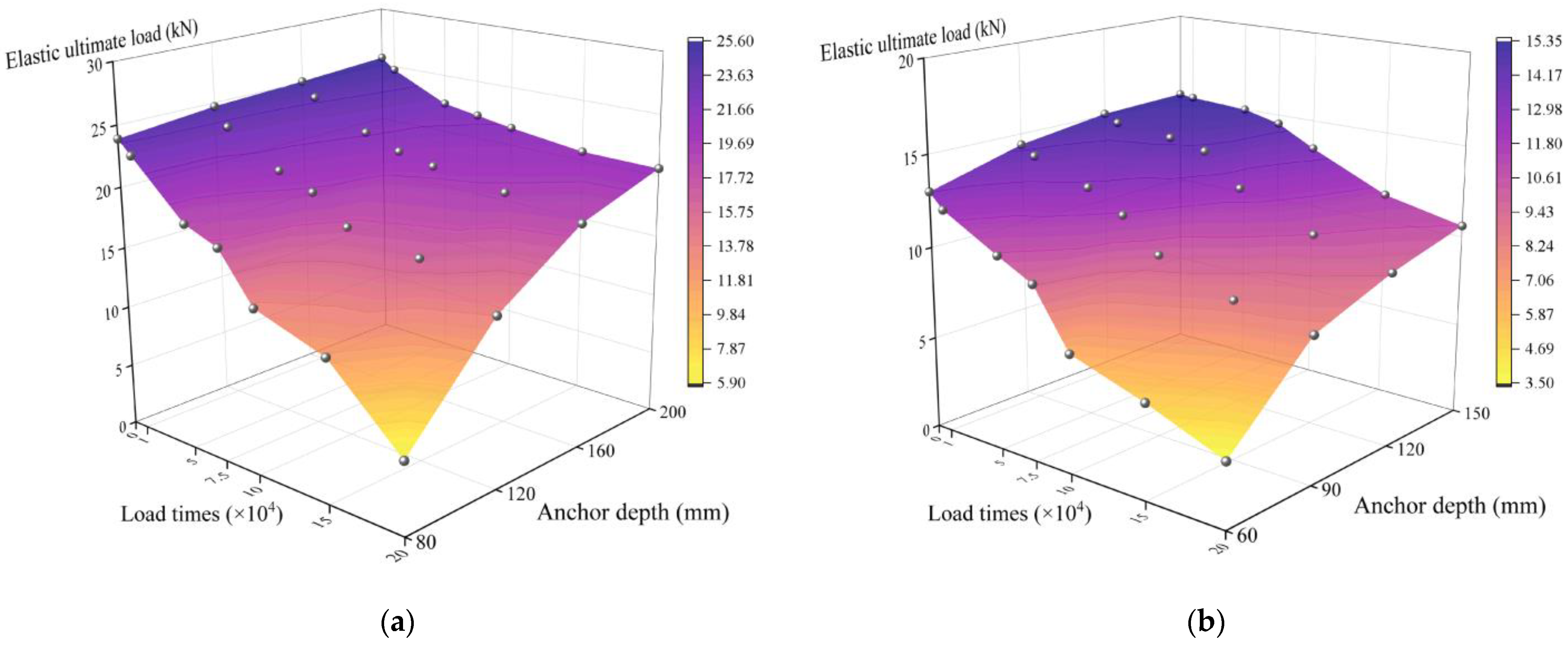
| Design Grade | Test Block 1 Compressive Strength (MPa) | Test Block 2 Compressive Strength (MPa) | Test Block 3 Compressive Strength (MPa) | Average Compressive Strength (MPa) |
|---|---|---|---|---|
| C35 | 36.3 | 37.4 | 37.0 | 36.9 |
| Diameter (mm) | Average Yield Tension (kN) | Average Yield Strength (MPa) | Average Ultimate Tension (kN) | Mean Ultimate Strength (MPa) |
|---|---|---|---|---|
| 6 | 12.08 | 427 | 17.35 | 614 |
| 8 | 22.22 | 455 | 30.33 | 603 |
| Test Items | Standard Requirements | Performance Data | Standards | |
|---|---|---|---|---|
| Splitting Tensile Strength | ≥8.5 MPa | 12.5 MPa | GB 50728-2011 | |
| Bending Strength | ≥50 MPa | 67.2 MPa | GB/T 2567-2008 | |
| Compressive Strength | ≥60 MPa | 87.3 MPa | GB/T 2567-2008 | |
| Bond Strength Between Rebar and Concrete under Constraint Conditions | C60, C25, L = 125 mm | ≥17 MPa | 26.4 MPa | GB 50728-2011 |
| Heat Distortion Temperature (HDT) | ≥60 °C | 66.1 °C | ISO 75-2: 2003 | |
| Specimen Number | Diameter of Rebar (mm) | Anchor Depth (mm) | Load Times (×104) | Ultimate Load (kN) | Failure Mode |
|---|---|---|---|---|---|
| A1 | 8 | 80 | 0 | 30.79 | Rebar fracture |
| A2 | 8 | 80 | 1 | 30.16 | Rebar fracture |
| A3 | 8 | 80 | 5 | 30.37 | Rebar fracture |
| A4 | 8 | 80 | 10 | 29.42 | Rebar fracture |
| B1 | 8 | 120 | 0 | 34.72 | Rebar fracture |
| B2 | 8 | 120 | 1 | 28.42 | Rebar fracture |
| B3 | 8 | 120 | 5 | 30.03 | Rebar fracture |
| B4 | 8 | 120 | 10 | 30.32 | Rebar fracture |
| C1 | 8 | 160 | 0 | 30.80 | Rebar fracture |
| C2 | 8 | 160 | 1 | 30.19 | Rebar fracture |
| C3 | 8 | 160 | 5 | 29.86 | Rebar fracture |
| C4 | 8 | 160 | 10 | 29.90 | Rebar fracture |
| D1 | 6 | 60 | 0 | 19.16 | Rebar fracture |
| D2 | 6 | 60 | 1 | 19.92 | Rebar fracture |
| D3 | 6 | 60 | 5 | 19.38 | Rebar fracture |
| D4 | 6 | 60 | 10 | 17.46 | Bonding failure |
| E1 | 6 | 90 | 0 | 19.91 | Rebar fracture |
| E2 | 6 | 90 | 1 | 19.35 | Rebar fracture |
| E3 | 6 | 90 | 5 | 19.48 | Rebar fracture |
| E4 | 6 | 90 | 10 | 19.00 | Rebar fracture |
| F1 | 6 | 120 | 0 | 19.45 | Rebar fracture |
| F2 | 6 | 120 | 1 | 19.50 | Rebar fracture |
| F3 | 6 | 120 | 5 | 18.97 | Rebar fracture |
| F4 | 6 | 120 | 10 | 19.37 | Rebar fracture |
| Name of Specimen | Measured Value (kN) | Simulation Value (kN) | Ratio |
|---|---|---|---|
| B1 measured | 23.61 | 24.70 | 0.956 |
| B2 measured | 22.74 | 23.20 | 0.980 |
| B3 measured | 19.70 | 20.60 | 0.956 |
| B4 measured | 15.00 | 17.40 | 0.862 |
Disclaimer/Publisher’s Note: The statements, opinions and data contained in all publications are solely those of the individual author(s) and contributor(s) and not of MDPI and/or the editor(s). MDPI and/or the editor(s) disclaim responsibility for any injury to people or property resulting from any ideas, methods, instructions or products referred to in the content. |
© 2023 by the authors. Licensee MDPI, Basel, Switzerland. This article is an open access article distributed under the terms and conditions of the Creative Commons Attribution (CC BY) license (https://creativecommons.org/licenses/by/4.0/).
Share and Cite
Chen, K.; Zhang, L.; Wang, X. Study on Bond Anchorage Behavior of Small-Diameter Rebar Planting under Medium and Low Cycle Fatigue Loads. Appl. Sci. 2023, 13, 7784. https://doi.org/10.3390/app13137784
Chen K, Zhang L, Wang X. Study on Bond Anchorage Behavior of Small-Diameter Rebar Planting under Medium and Low Cycle Fatigue Loads. Applied Sciences. 2023; 13(13):7784. https://doi.org/10.3390/app13137784
Chicago/Turabian StyleChen, Kui, Linhao Zhang, and Xianqiao Wang. 2023. "Study on Bond Anchorage Behavior of Small-Diameter Rebar Planting under Medium and Low Cycle Fatigue Loads" Applied Sciences 13, no. 13: 7784. https://doi.org/10.3390/app13137784
APA StyleChen, K., Zhang, L., & Wang, X. (2023). Study on Bond Anchorage Behavior of Small-Diameter Rebar Planting under Medium and Low Cycle Fatigue Loads. Applied Sciences, 13(13), 7784. https://doi.org/10.3390/app13137784






